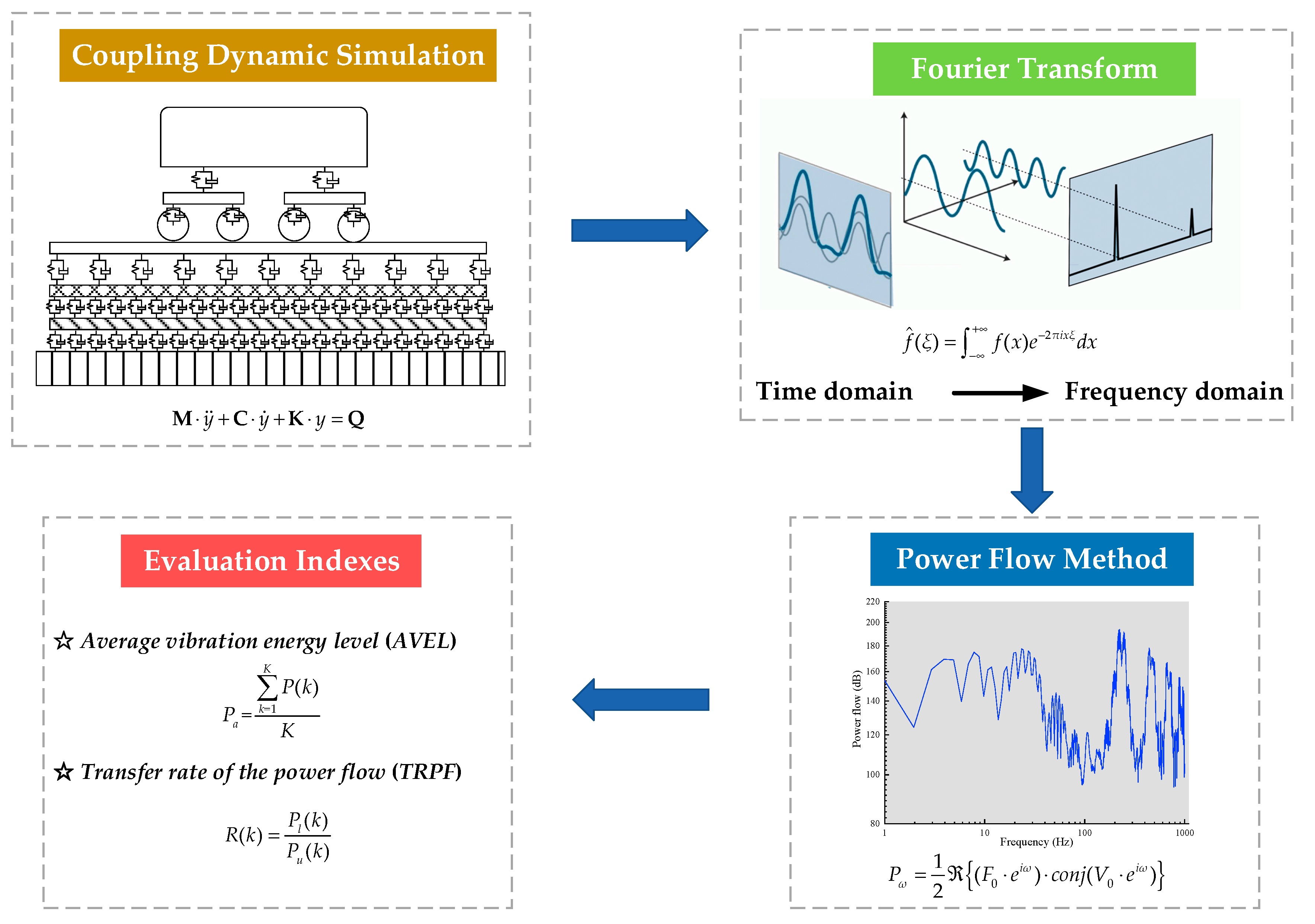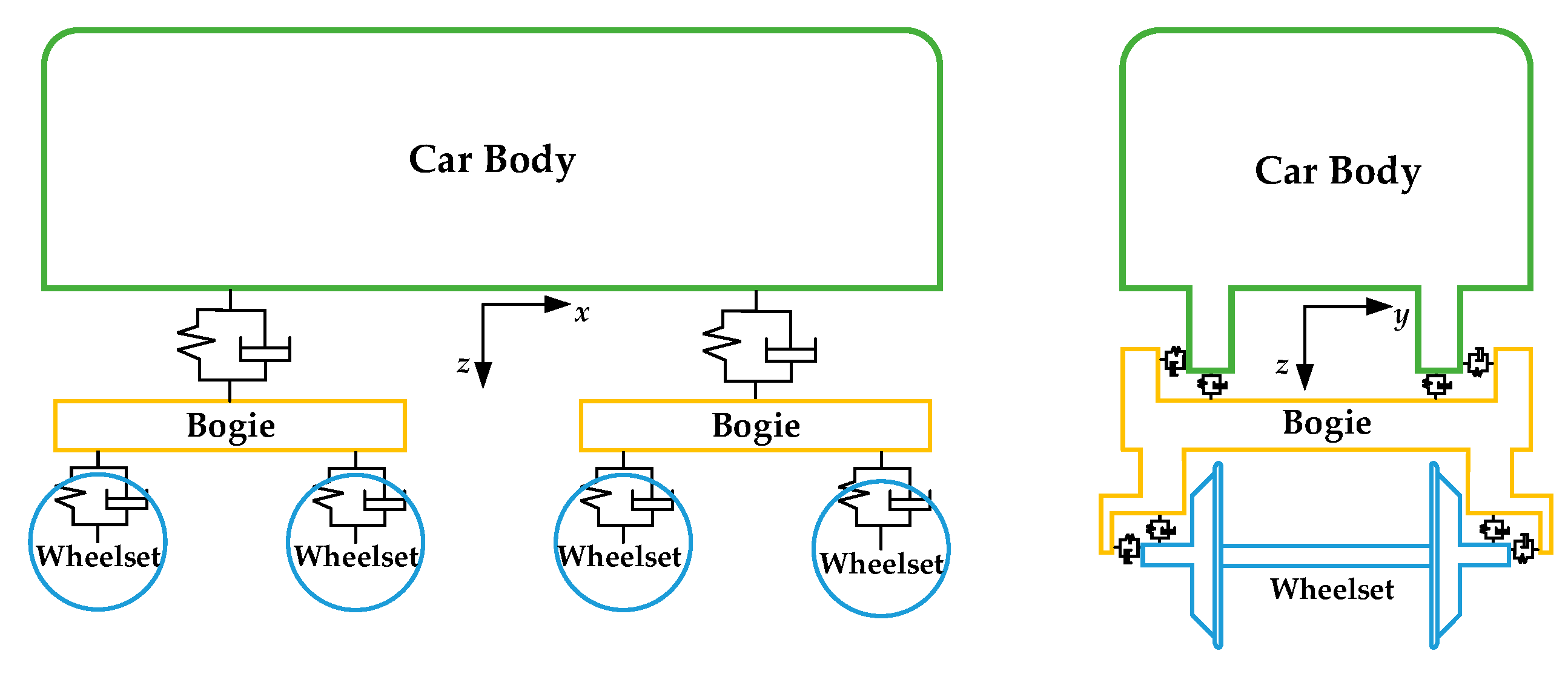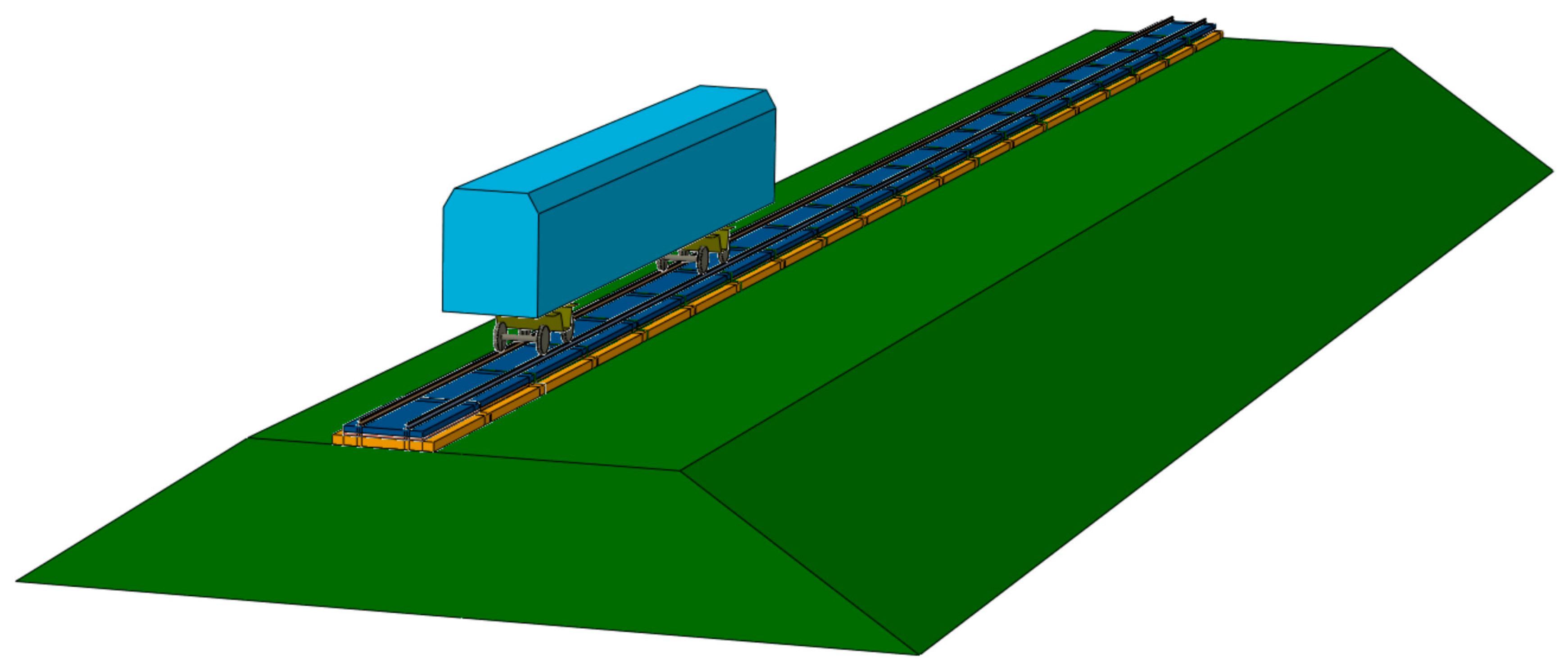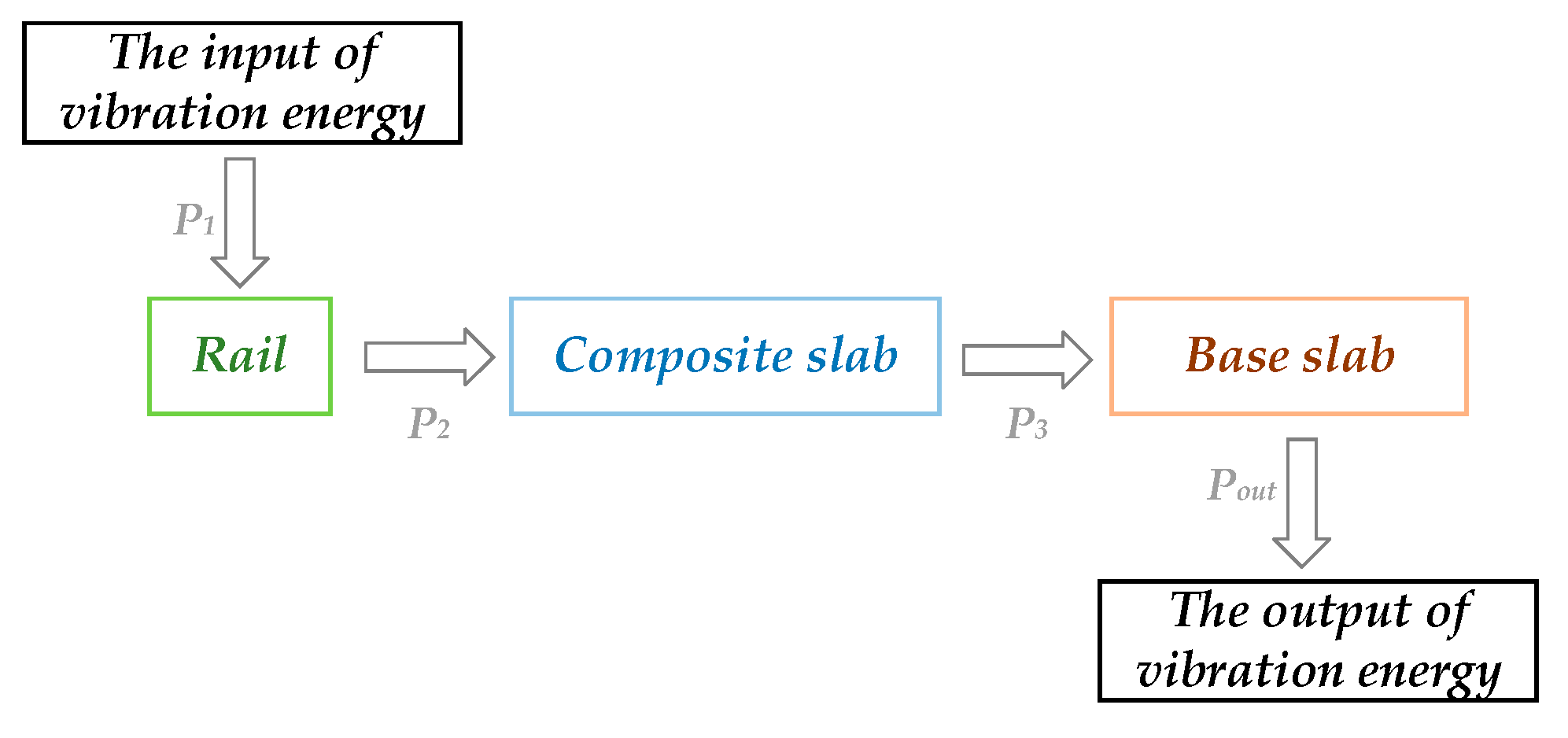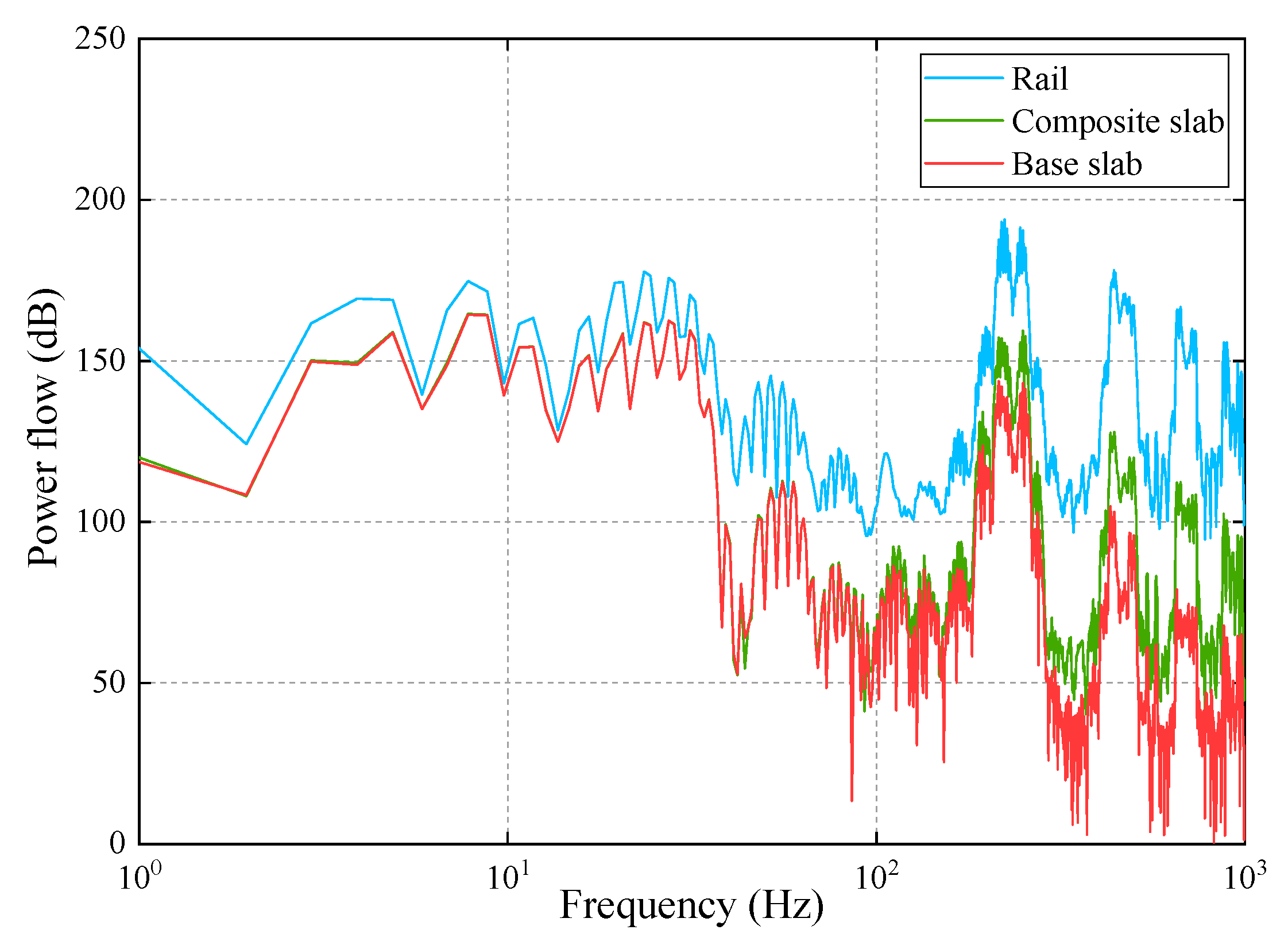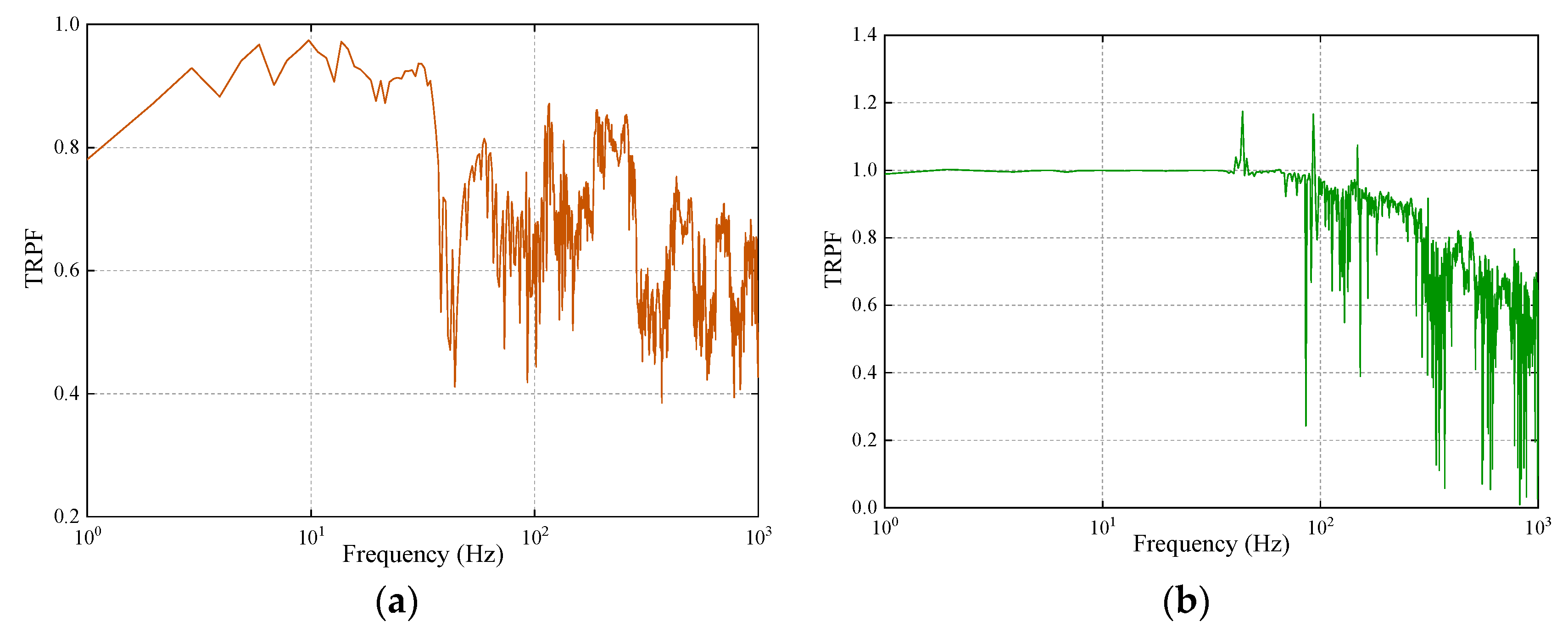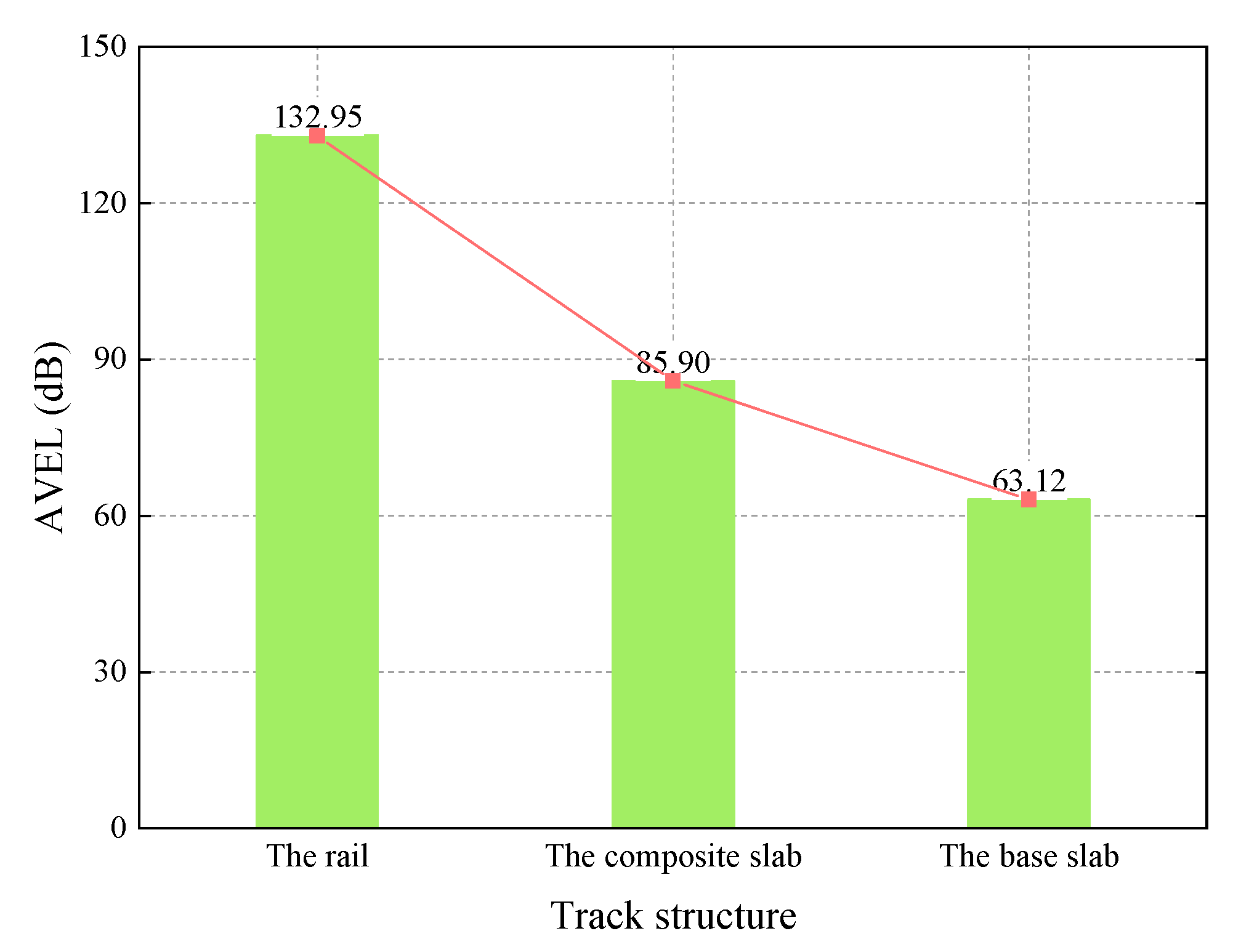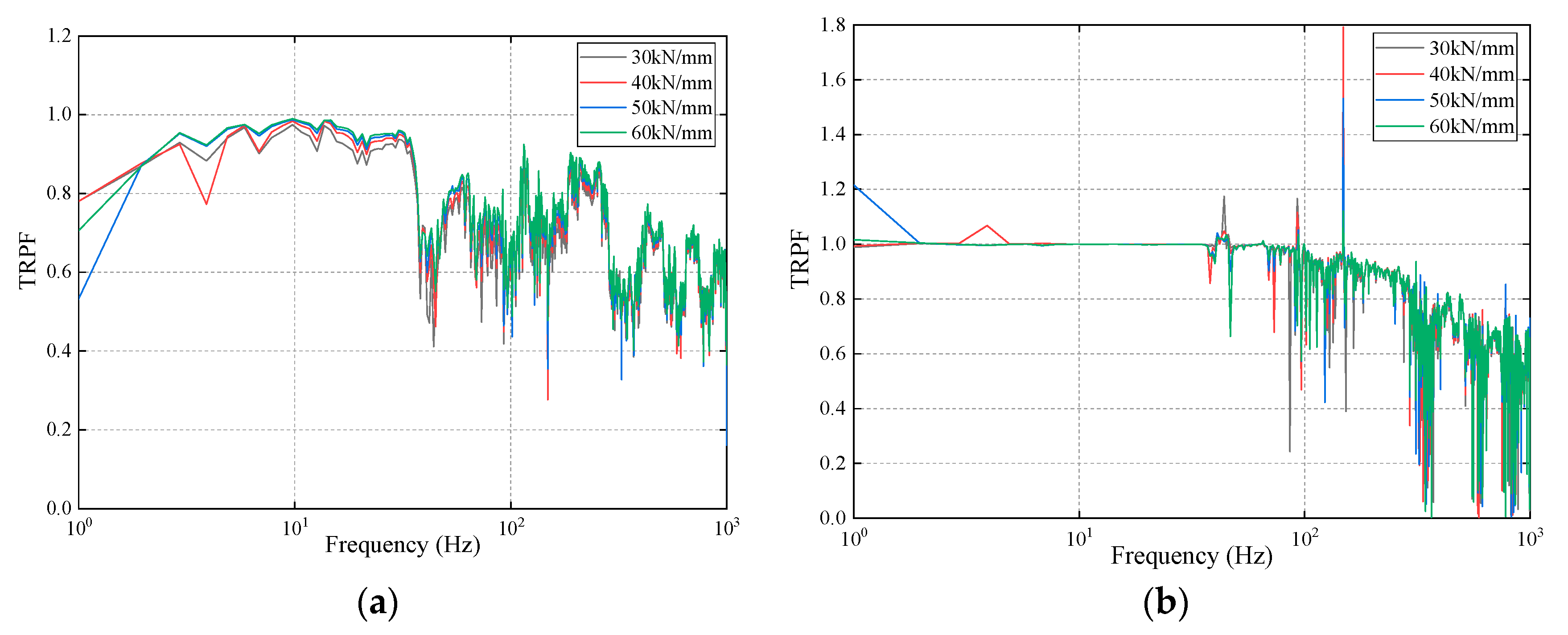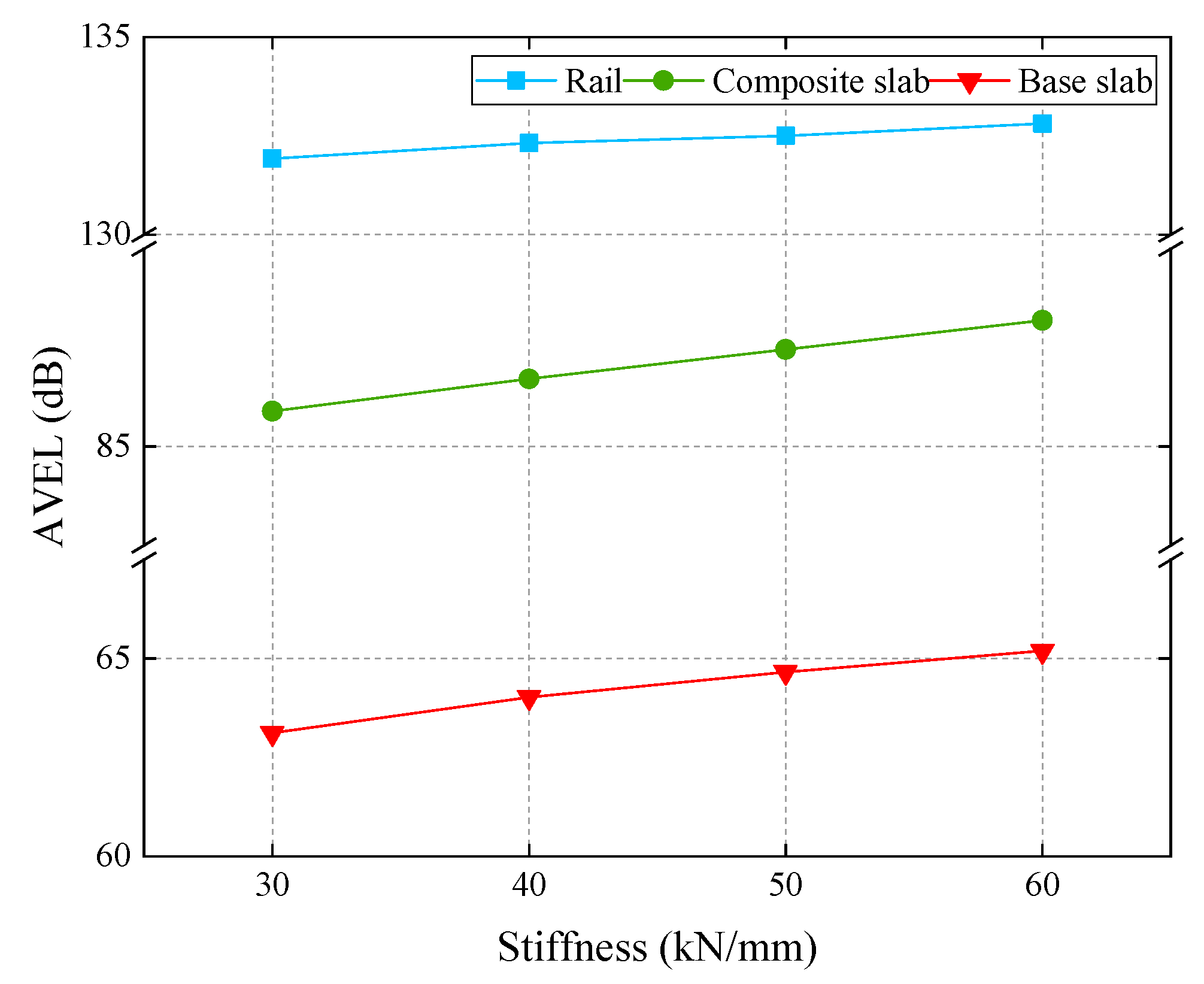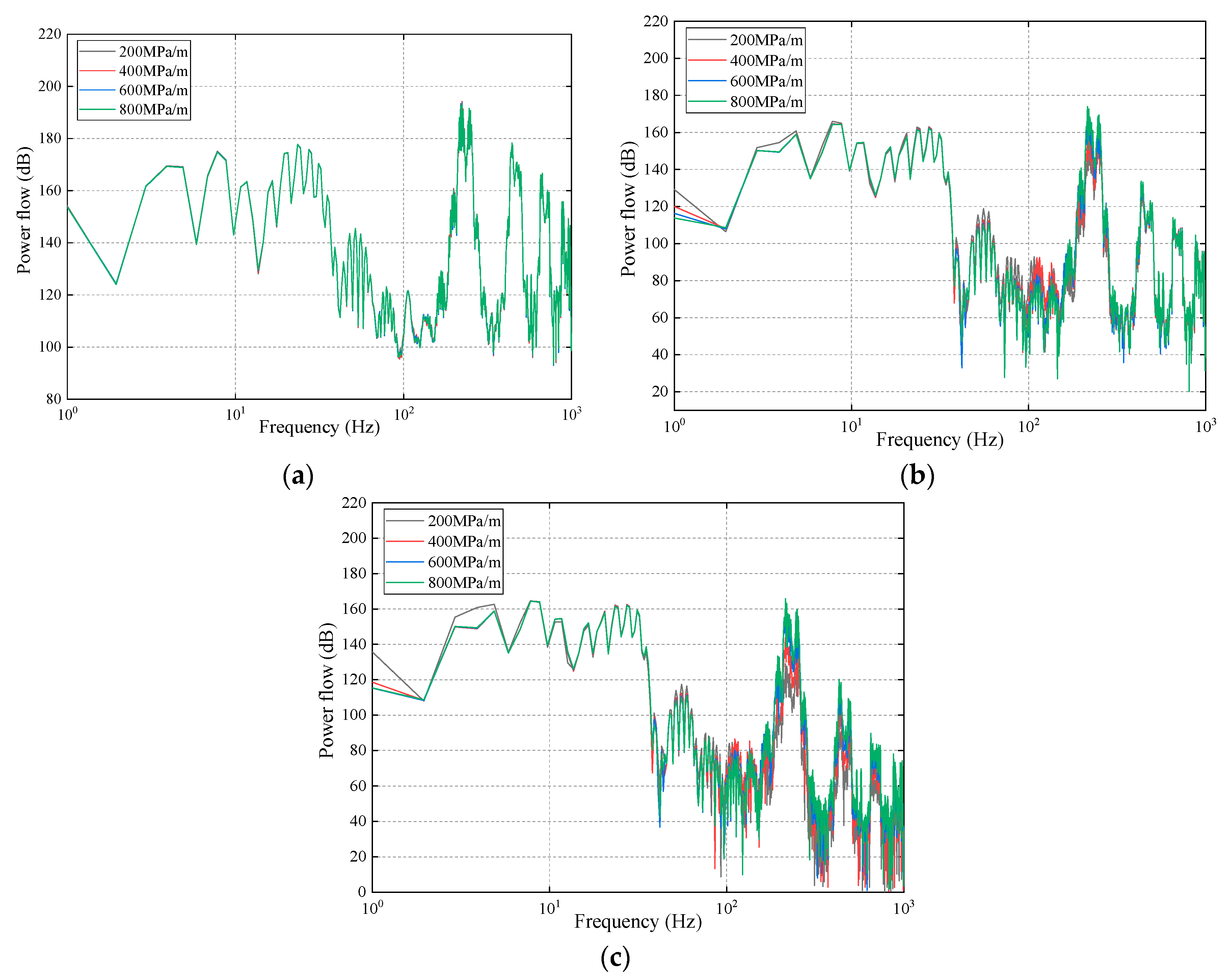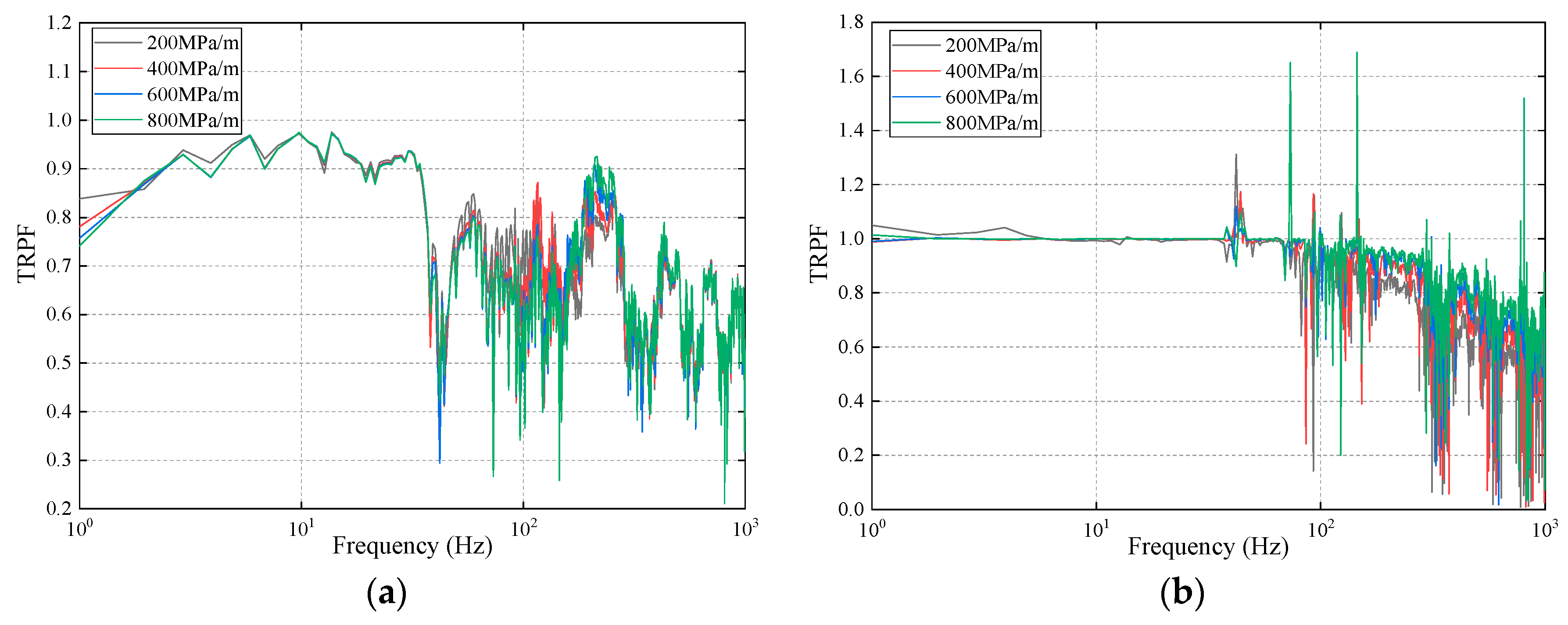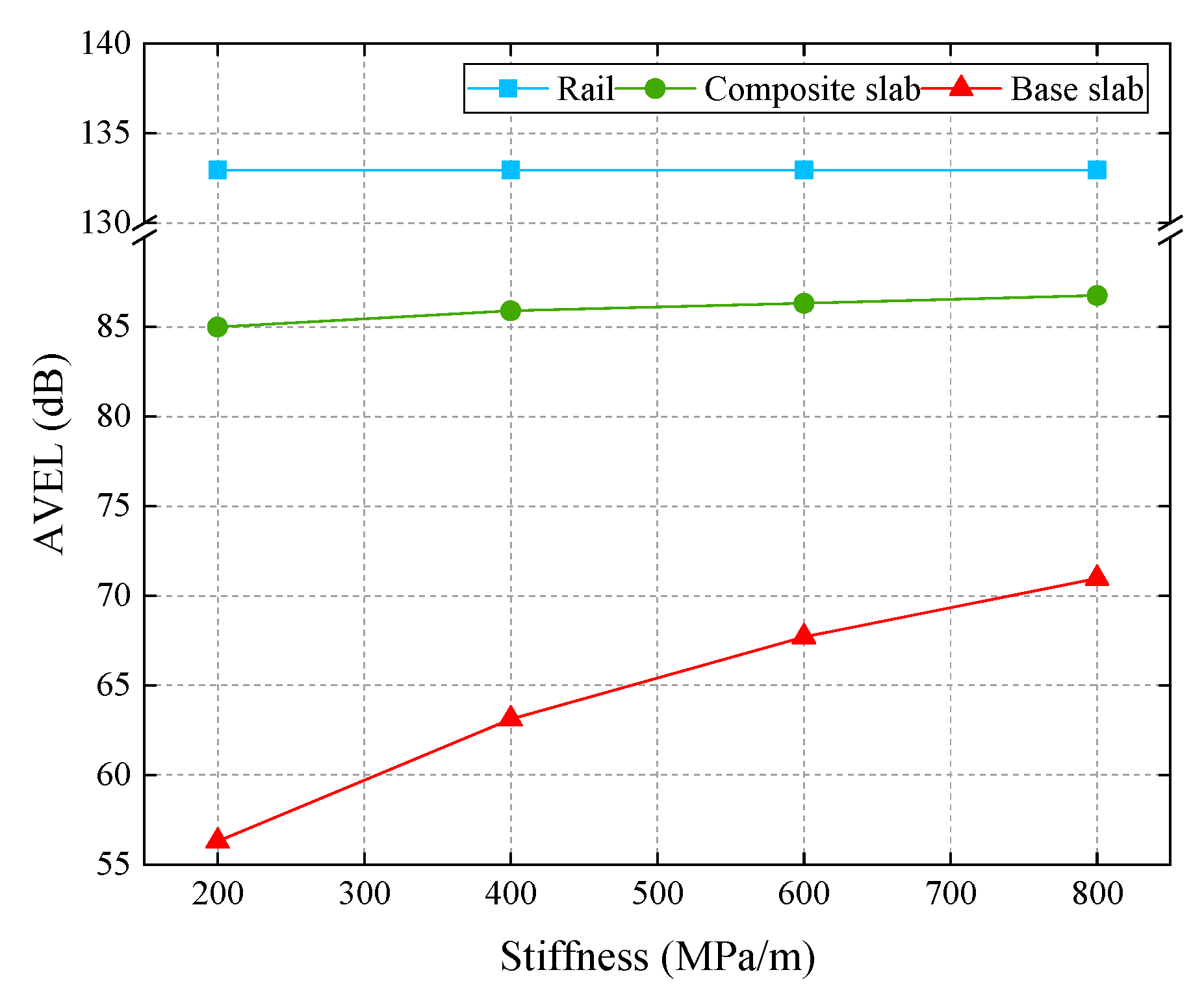1. Introduction
The vibration induced in the railway system has still been a crucial problem during the construction and operation period, which has drawn a lot of attentions from scholars and researchers. Tang et al. [
1] developed a finite element (FE) model to investigate the vibration behaviors of embankment induced by high-speed train in seasonally frozen regions and the model was validated by the field test. Further, the results convincingly indicated that the vibration mitigation effect of the wave impeding barrier (WIB) would be improved when its modulus and size increased or the embedded depth decreased. Rådeström et al. [
2] established a single-degree-of-freedom model to investigate the possibility of reducing the acceleration of one of these bridges to an acceptable level by using post-installed viscous dampers. Moreover, the results indicated that the proposed retrofit method can reduce the accelerations to an acceptable level. Ferreira and López-Pita [
3] built a numerical model to correctly predict train/track dynamic response not only instantaneously but also in a long-term perspective. In addition, the results were evaluated in the perspective of track vibrations mitigation and track maintenance needs. Olivier et al. [
4] developed an FE model to investigate the effect of embankment stiffness on ground vibration levels both within and at distance from the track-embankment structure, and it is found that ground vibration levels are sensitive to embankment stiffness, with stiffer embankments resulting in greatly reduced vibration levels.
The vibration and noise induced in China high-speed railway (HSR) system have already raised concerns because plenty of complaints about these problems have been received by the relevant department from the residents along the railways, some institution using the high accuracy instruments, schools, hospitals, etc. The ballastless track system has been widely employed in China HSR system to reduce vibration and noise, which is named China Railways Track System (CRTS). The CRTS-III track has been widely adopted in many HSR lines, such as Zhengzhou–Xuzhou HSR line, Beijing–Shenyang HSR line, Shangqiu–Hangzhou HSR line [
5], and so on. In addition, the CRTS-III track has been exported overseas so far. Further, the CRTS-III track consists of rails, the fasteners system, the track slab, the self-compacting concrete, the rubber damping pad, the base slab, and so on [
6].
To solve the problems of the ambient vibration and noise induced by the HSR system in China, a large number of researches have been conducted on the CRTS-III track. The rubber damping pad connects the self-compacting concrete with the base slab, and it can effectively absorb the vibration and reduce the noise. The rubber damping pad has been studied for many years in China. Xin and Gao [
7] established a vehicle-track-bridge coupling system dynamics model to investigate the effectiveness of elastic materials in vibration reducing. The results demonstrated that elastic materials like slab mat layer inserted between slab track and bridge can reduce vibration transmitted from track into the bridge. Zhao and Wang [
8] studied the damping effect of rubber absorbers for ballastless track on viaduct by field test. Moreover, the results showed that after laying rubber absorbers, the vibrations of rails and track slabs above rubber absorbers have been slightly enlarged, but the impact is very little. Ren et al. [
9] developed a two-dimension CRTS-III track model in frequency domain to study its vibration transmission and vibration isolation performance. In addition, some recommended slab track parameters were put forward based on the numerical simulation to improve the vibration isolation efficiency. Xin et al. [
10] established the dynamic analysis model for high-speed train and CRTS-Ⅲ track coupled system to conduct the analysis of the dynamic effects and the structure optimization of damping layers of CRTS-Ⅲ track. Zhao and Wang [
11] evaluated and analyzed the effects of the rubber mats on noise and vibration of the vehicle, the track system, the bridge, and so on based on the field experiment in one China HSR line.
So far, many researches have made contributions to reduce the ambient vibration induced by the track structure, but these researches ignore the energy redistribution due to the application of rubber damping pads. In order to study the energy properties of the track structure, the energy method needs to be applied. Further, the power flow method based on the vibration isolation theory has been widely used to investigate the vibration energy of the vibration isolation system, besides the power-flow indexes have been taken as the vibration evaluation standard. At present, the power flow method has been widely employed in the areas of mechanical engineering, marine engineering, aerospace engineering, etc. Goyder and white [
12,
13,
14] proposed the concept of the vibrational power flow and applied it to study the vibration of built-up structures in 1980. From that on, many power flow methods have made progress, and among those, the mobility power flow, due to the characteristics of the clear concept, simple calculation, and the applicability of studying at low and medium frequency, has been one of the most extensively used methods of the vibration researches. Petersson and Plunt [
15] first put forward the concept of mobility, the theoretical background, and basic experimental studies, which provided the theoretical basis on the application of the mobility power flow method in practical engineering. Hussein and Hunt [
16] developed a new method based on calculating the mean power flow to evaluate the performance of vibration countermeasures for underground tunnels of underground railways in the wavenumber-frequency domain. Li and Wu [
17] presented a general procedure based on the force method to obtain the power flow within a coupled vehicle–track–bridge system in urban rail transit systems, the point mobility of the system, and the dynamic interaction forces connecting various components.
To sum up, few researches have been conducted on the vibration-energy properties of the track structure in the HSR system. Therefore, in this paper, the mobility power flow method is employed to investigate the vibration-energy properties of the track structure in the HSR system, which is taken the CRTS-III track as the research objective. A fine spatial coupling dynamic model of the vehicle, the track system, and the subgrade is established in this paper. The influences of the stiffness of fasteners and the rubber damping pads on the vibration energy of the track structure are analyzed. This paper is of great importance to understand the vibration of the HSR track structure from the perspective of energy systematically and provides the theoretical basis on the mechanism of the vertical energy transfer of the track structure. Furthermore, this method can be also employed to study the vibration-energy properties of other type track structures in the HSR system.
3. Results and Discussion
The power flows and corresponding evaluation indexes of the track structure under irregularities and various stiffness of fasteners and rubber damping pads are calculated, when the vehicle speed is set as 250 km/h.
3.1. Power Flow of the Track Structure under Irregularities
The dynamic responses of the track structure are obtained under the irregularities measured in China HSR, and then the power flow of the track structure is analyzed based on the dynamic responses mentioned above, which is illustrated in
Figure 7.
It can be observed from
Figure 7 that the power flow of the track structure decreases from top to bottom among the frequency range considered, and the decreasing trend is obvious. This occurrence of decreasing trend is because the vibration energy, which is generated by the interaction of the wheel and the rail, is stored and consumed partly in every structure during the transferring process from top to bottom. In addition, there are many peaks in the power flow of the track structure among the frequency range considered. Furthermore, the peaks of the track structure at the frequencies of 220 Hz and 250 Hz are much bigger, which are related to the vibration characteristics of the track structure and the irregularities. Additionally, the peaks of the track structure at the frequencies of 220 Hz and 250 Hz are much bigger, which are related to the vibration characteristics of the track structure and the irregularities. Because the irregularities employed in our model are sampled at the interval of 0.5 m, so the impact between the rail and wheel is at a certain frequency when the running speed is constant. Besides, the components of the track structure have several resonance frequencies. Therefore, the components of the track structure reach the peaks of the power flow at those frequencies.
The TRPF of the track structure is shown in
Figure 8. Further, it can be seen from
Figure 8 that the TRPFs from the rail to the composite slab are always below 1.0, but those from the composite slab to the base slab sometimes exceed 1.0 whereas they are smaller than 1.0 on the whole. The reason why the TRPFs sometimes are larger than 1.0 is that at these frequencies the structure occurs the resonance phenomenon. What’s more, at the frequency ranges of 34 to 44 Hz, 65 to 102 Hz, 115 to 148 Hz, and 264 to 1000 Hz, the TRPFs from the rail to the composite slab tend to decrease, which are caused by the stiffness and damping of fasteners. As a result, the fasteners have a better vibration damping performance at those frequency ranges mentioned above. Besides, the TRPFs from the composite slab to the base slab tend to reduce at the frequency range of 100 to 1000 Hz, which are induced by the stiffness and damping of the rubber damping pads. It can be concluded that the rubber damping pads can achieve an excellent vibration damping effect at the frequency range of 100 to 1000 Hz.
The AVEL of the track structure is demonstrated in
Figure 9. It can be seen that similar to the power flow, the AVEL deceases obviously from the top to the bottom of the track structure, which is caused by the energy stored and consumed in every structure as well. Besides, the decrement of the AVEL from the rail to the composite slab is bigger than that from the composite slab and the base slab.
3.2. The Influence of the Stiffness of Fasteners on the Power Flow
To compare and analyze the influence of the stiffness of fasteners, the stiffness is set as 30 kN/mm, 40 kN/mm, 50 kN/mm, and 60 kN/mm, and the power flows, the TRPFs, and the AVELs are calculated.
The power flows of the track structure employing different stiffness of fasteners are illustrated in
Figure 10. It can be seen from
Figure 10a that the peak values of the rail decrease with the increase of fasteners’ stiffness at the frequency range of 3 to 36 Hz. The differences are seriously obvious when the fastener’s stiffness increases from 30 kN/mm to 40 kN/mm, and the maximum difference can reach to 4.92 dB. When the stiffness of fasteners exceeds 40 kN/mm, the differences of the power flows of the rail are less obvious than those mentioned above. Though the differences of the power flows of the rail are small from 36 to 1000 Hz, it can be noticed that when the stiffness of fasteners is 60 kN/mm the power flows are maximum by and large.
Figure 10b shows that the power flows of the composite slab does not simply change with the increases of fasteners’ stiffness. In the frequency range of 2 to 8 Hz, the power flows, when using the fasteners with stiffness of 40 kN/mm, are distinctly the minimum. Due to the track structure consisting of many components, the vibrations are interactional. Therefore, when employing certain stiffness, the power flows may be the minimum at a certain range of frequencies but may be the maximums at other ranges of frequencies. Although there are few differences in the power flows in other frequency ranges, it can be seen that the power flows basically reach the maximum when the stiffness of fasteners is 60 kN/mm. Besides, the power flows, when adopting the fasteners with stiffness of 30 kN/mm, are the minimum at the frequencies of 38 Hz, 42 Hz, 55 Hz, and so on.
It can be clearly observed from
Figure 10c that the power flows of the base slab are the minimum at the frequency range of 2 to 8 Hz when employing the fasteners with stiffness of 40 kN/mm. Similar to the power flows of the composite slab, there are also few differences in other frequency ranges. However, at the frequencies of 38 Hz, 44 Hz, 73 Hz, and so on, the power flows of 40 kN/mm reach to the minimum. Besides, the power flows of 30 kN/mm also reach to the minimum when the frequencies are 42 Hz, 86 Hz, 152 Hz, and so on. The power flows of 60 kN/mm are basically the maximum among 1 to 1000 Hz.
The TRPFs of the track structure applying different stiffness of fasteners are shown in
Figure 11.
Figure 11a demonstrates that the TRPFs from the rail to the composite slab are all below 1.0 among the frequency range considered and increase with the growth of the stiffness of fasteners except for some frequencies. Especially among the frequency range of 5 Hz to 37 Hz, the variations of the TRPFs can be seen obviously. Moreover, the TRPFs of 60 kN/mm reach to the maximum among the frequency range considered.
From
Figure 11b, it can be observed that the TRPFs from the composite slab to the base slab are close to 1.0 when the frequency is below 37 Hz. Except for some frequencies, the TRPFs of four conditions are basically smaller than 1.0 and have few differences. What’s more, the maximum TRPFs appear at the frequency of 148 Hz, which reaches 1.79 when employing the fasteners with stiffness of 40 kN/mm. Nevertheless, the TRPFs of four conditions all show a downward trend when the frequency is larger than 148 Hz.
The AVEL of the track structure is demonstrated in
Figure 12. It indicates that the AVELs of the track structure decrease with the growth of the stiffness of fasteners. What’s more, the increments of the composite slab and the base slab are more obvious than those of the rail. The increasing of the stiffness of fasteners causes that the vibration energy stored in the track structure increase. As a consequence, the AVEL of the track structure is sensitive to the variations of the stiffness of fasteners.
It can be concluded that with the rising of the stiffness of fasteners, the vibration energy stored in the track structure increase, and the increments of the composite slab and the base slab are more obvious.
3.3. The Influence of the Stiffness of Rubber Damping Pads on the Power Flow
In order to investigate the influence of the stiffness of rubber damping pad on the power flow, four kinds of stiffness are chosen, which are 200 MPa/m, 400 MPa/m, 600 MPa/m, and 800 MPa/m. In addition, the power flows, the TRPFs, and the AVELs are compared under these four conditions.
The power flows of the track structure with four kinds of stiffness is shown in
Figure 13. It can be clearly seen from
Figure 13a that the power flows of the rail nearly have no difference under four conditions, that is, the variations of the stiffness of the rubber damping pads cannot affect the power flows of the rail.
Figure 13b illustrates that the power flows of the composite slab with the stiffness of 200 MPa/m are the maximum when the frequency is below 9 Hz, and the power flows of 800 MPa/m reach to the minimum in the frequency range of 46 to 156 Hz. However, the power flows of 800 MPa/m are the maximum among the frequency range of 165 to 480 Hz. Except for those frequency ranges mentioned above, the power flows under four conditions exhibit very small deviations.
It can be observed from
Figure 13c that the power flows of the base slab with the stiffness of 200 MPa/m are the maximum in the frequency ranges of 1 to 8 Hz and 39 to 107 Hz. Moreover, the power flows of 800 MPa/m reach the maximum at the frequency range of 166 to 1000 Hz, but the power flows of 800 MPa/m achieve the minimum among the frequency ranges of 46 to 76 Hz and 96 to 123 Hz. What’s more, it can be found that the power flows of the base slab increase with the rising of the stiffness of the rubber damping pads at the higher frequency.
The TRPF of the track structure under four conditions is demonstrated in
Figure 14. It can be found from
Figure 14a that the TRPF from the rail to the composite slab is all below 1.0 in the frequency range considered. The TRPF of 800 MPa/m reaches the minimum in the frequency ranges of 3 to 10 Hz, 18 to 30 Hz, and 48 to 162 Hz, on the contrary, the TRPF of 800 MPa/m is the maximum at the frequency range of 166 to 490 Hz. In other frequency ranges, the TRPF shows few differences.
Figure 14b indicates that the TRPF from the composite slab to the base slab is basically below 1.0 except some frequencies. And the TRPF increases with the growth of the stiffness of rubber damping pads on the whole. It can be found that the bigger stiffness makes more energy transfer from the composite slab to the base slab, which goes against the reduction of ambient vibration.
The AVEL is illustrated in
Figure 15. It can be clearly found from
Figure 15 that the AVELs of the base slab increase obviously with rising of the stiffness of rubber damping pads, and those of the composite slab also increase with the growth of the stiffness. However, the AVELs of the rail barely change with the variations of stiffness. As a result, the AVELs of the composite slab and the base slab are more sensitive to the variations of the stiffness of rubber damping pads than those of the rail.
Overall, it can be clearly found that the variations of the stiffness of rubber damping pads have little influence on the vibration energy stored in the rail. However, with the growth of the stiffness of rubber damping pads, the vibration energy stored in the composite slab and the base slab both increases. Among both, the changes of the base slab are particularly evident.
4. Conclusions
According to the rigid-flexible coupling dynamic theory, the vehicle-track-subgrade model is established to investigate the vibration-energy properties of the track structure under irregularities and different stiffness of fasteners and rubber damping pads. Furthermore, the detailed conclusions are drawn as follows:
(1) The vibration energy decreases from top to bottom of the track structure among the frequency considered, and the decreasing trend is obvious. The occurrence of the phenomenon is because the vibration energy, which is generated by the interaction of the wheel and the rail, is stored and consumed partly in every structure in the process of transferring from top to bottom.
(2) With the increase of the stiffness of fasteners, the vibration energy of the rail, the composite slab, and the base slab increase as well. In other words, the vibration energy of the track structure is sensitive to the stiffness of fasteners. Moreover, it also can be concluded that with the rising of the stiffness of fasteners, the vibration energy stored in the track structure augments likewise. Therefore, the fasteners employed should have reasonable stiffness, because the bigger stiffness will make the ambient vibration increase while the smaller stiffness will influence the running stability of vehicles even induce the rail corrugation. Based on that, the proposed value of the stiffness of the fasteners for the case under this study is 40 kN/mm.
(3) With the growth of the stiffness of rubber damping pads, the vibration energy of the rail has no variations basically, but the vibration energy of the composite slab and the base slab both increases. In addition, the variations of the base slab are particularly evident. Namely, the vibration energy of the composite slab and the base slab is more sensitive to the stiffness of rubber damping pads than that of the rail. As a result, the rubber damping pads applied is supported to have suitable stiffness, because the bigger stiffness will make the ambient vibration increase while the small stiffness will not be conducive to maintaining the track geometry. Based on that, the proposed value of the stiffness of the rubber damping pads for the case under this study is 400 MPa/m.
The conclusions drawn in this paper can provide a new perspective and method to study the vibration-energy properties and select the reasonable stiffness of the fasteners and the rubber damping pads of the CRTS-III track. Furthermore, this method can be also employed to study the vibration-energy properties of other type track structures in the HRS system.
